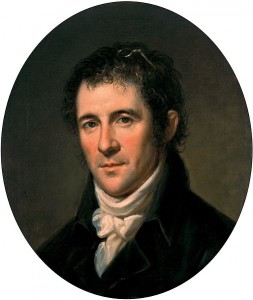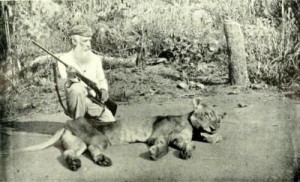NAMES OF THE WEEK from: 2014 2015 2016 2017 2018 2019 2020 2021 2022 2023 2024

Paradiancistrus christmasensis. From: Schwarzhans, W. and P. R. Møller. 2011. New Dinematichthyini (Teleostei: Bythitidae) from the Indo-West Pacific, with the description of a new genus and five new species. The Beagle, Records of the Museums and Art Galleries of the Northern Territory v. 27: 161-177.
25 December 2013
Paradiancistrus christmasensis Schwarzhans & Møller 2011
Christmas Island is a territory of Australia located in the eastern Indian Ocean. The island received its name when Capt. William Mynors of the Royal Mary, a vessel of the English East India Company, sailed past it on Christmas Day in 1643. This viviparous brotula (Order Ophidiiformes, Family Bythitidae) is known from only one specimen collected on the northern side of Christmas Island in 1986. Merry Christmas!
![Sinocyclocheilus tileihornes. From: Mao, W.-N. , Z.-M. Lu, W.-X. Li, H.-B. Ma and G. Huang 2003. A new species of Sinocyclocheilus (Cyprinidae) from [a] cave of Yunnan, China. Journal of Zhanjiang Ocean University v. 23 (no. 3): 1-3.](https://etyfish.org/wp-content/uploads/2013/12/tileihornes-300x101.jpg)
Sinocyclocheilus tileihornes. From: Mao, W.-N. , Z.-M. Lu, W.-X. Li, H.-B. Ma and G. Huang 2003. A new species of Sinocyclocheilus (Cyprinidae) from [a] cave of Yunnan, China. Journal of Zhanjiang Ocean University v. 23 (no. 3): 1-3.
Sinocyclocheilus tileihornes Mao, Lu & Li 2003
It’s not considered particularly good form to latinize an Anglo-Saxon word by adding an –um or an –us to the end of it. (Remember Biggus Dickus in Monty Python’s Life of Brian?) But some Chinese ichthyologists have done just that. Here are a few examples:
- The minnow Anabarilius goldenlineus, named for three golden lines on its back and sides.
- The loach Triplophysa bellibarus, named for bars on its belly.
- The loach Yunnanilus tigervinus, named for the black “tiger veins” (or stripes) on its sides.
Our favorite is the cave-dwelling cyprinid Sinocyclocheilus tileihornes from Yunnan, China. It’s named for the top of the horn-like bony protuberance on its head, which is forked, its authors say, like a Chinese roof tile.
So far, we’ve seen these types of “fake Latin” names only from China. We don’t know why, but we can hazard to guess that it’s related to many Chinese scientists’ unfamiliarity with Romance languages. What do you think?
Are there any other examples in the Chinese literature from taxa other than fishes?
11 December 2013
Brevoortia tyrannus (Latrobe 1802)
Benjamin Henry Latrobe (1764-1820) is known as the “Father of American Architecture.” He designed the United States Capitol, the first cathedral in the U.S., painted topological and landscape watercolors, and was engineering a waterworks project in New Orleans when he contracted yellow fever there and died. He also dabbled in natural history and was responsible for two of the most humorously historical and political names in zoological nomenclature.
In 1802, the American Philosophical Society published Latrobe’s 1799 paper describing a large herring from the Chesapeake Bay of the United States, and the parasitic isopod, or fish louse, that lived in its mouth. He called the isopod Oniscus (now Cymothoa) praegustator, or “pretaster,” and the herring Clupea (now Brevoortia) tyrannus, after the absolute rulers of ancient Rome, the Tyranni, who forced food-tasters to test their food for poison.
In addition to this historical allusion, Latrobe’s names may have reflected his enthusiasm for America’s independence from England.
“The oniscus resembles the minion of a tyrant …”, Latrobe wrote, “for he is not without those who suck him.”
In other words, this fish, like the tyrants of England, has parasites or hangers-on.
Note: Although the name Brevoortia tyrannus is now applied to the commercially important Atlantic Menhaden, some scholars believe that Latrobe had actually described the Alewife (Alosa pesudoharengus) instead. For details, see Porter, C. M. 1987. Benjamin Henry Latrobe and the nomenclature of two American fishes. Archives of Natural History (14) 1: 85-88. Whatever the case, Latrobe was quite the pioneer; his description of the herring appears to be the earliest valid description of any fish species published in the United States.
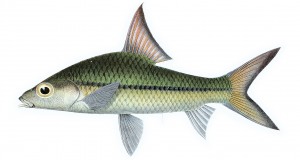
Cyclocheilichthys janthochir. From: Bleeker, P. 1860. Ichthyologiae Archipelagi Indici Prodromus, Auct., Volumen II. Cyprini. Ordo Cyprini. Karpers. Acta Societatis Regiae Scientiarum Indo-Neêrlandicae v. 7 (N. S., v. 2): 1-492 + i-xiii.
4 December 2013
Cyclocheilichthys janthochir (Bleeker 1854)
Sometimes the meaning of a name is hiding in plain sight.
Dutch medical doctor and prolific ichthyologist Pieter Bleeker (1819-1878) named this Indonesian minnow Systomus janthochir in 1854 (date sometimes given as 1853). As was the custom of the day, Bleeker did not provide an etymological explanation of the name. No problem. We’ll simply break down the name into its constituent Greek or Latin parts and see if our translation corresponds with any attributes Bleeker mentioned in his accompanying description.
The chir part of the name is almost certainly from cheiros, meaning hand. Bleeker and other ichthyologists often used chir or cheiros when referring to its evolutionary homolog, the pectoral fin.
The meaning of jantho was not so easy to figure out. We could not find the word in any Greek or Latin dictionaries. Since Bleeker sometimes incorporated the local vernacular into his names, we wondered if jantho was the Indonesian word or name for this fish. But there was no evidence supporting this conclusion. So we put the name into our etymological “cold case” file and came back to it every now and then to see if we had overlooked a clue. Sure enough, we did.
Bleeker used the jantho or janthi phrase in the names of several different fish species. When we checked them out, we noticed that all these fishes had violet somewhere in their coloration. Ianthinus is Greek for violet. Then we realized what Bleeker had done. He had modernized the Greek word by replacing the Latin “i” with the Roman “j.” Bleeker later expanded the description and gave the minnow a Dutch name: Violethandige Kringlipkarper (the Violet-handed Circle-lip Carp).
And yes, its pectoral fins are indeed violet.
27 November 2013
Copella vilmae Géry 1963
This may be the only time we use an article from Sports Illustrated magazine to confirm the meaning of a name.
In 1963, the French characin expert Jacques Géry described a lebiasinid, Copella vilmae, from the Peru-Colombia border. Géry did not indicate the identity of the “Vilma” honored in the name, but we were 99.9% positive it was Vilma Schultz, wife of ethnographer and tropical-fish collector Harald Schultz (1909-1966). After all, Harald collected the type of Copella vilmae, and we knew his wife’s name was Vilma because Géry named another fish, Hyphessobrycon vilmae, in her honor in 1966.
We found confirmation — and an explanation for the name — in a most unlikely source, a 1965 Sports Illustrated article about tropical-fish explorer and pet-book tycoon Herbert R. Axelrod.
The article is a fascinating portrait of Axelrod’s burgeoning tropical fish empire — not to mention his famous ego. (Did you know that Axelrod once refused to meet Jacques Cousteau because he thought Cousteau was a bore?) Harald Schultz, Axelrod’s collecting buddy in South America, warrants a few paragraphs. One of them mentions that Schultz sent a letter to Axelrod “announcing that he had at last found a fish beautiful enough” to be named for Schultz’s wife, Vilma. Since Axelrod financed some of Géry’s work, Géry often returned the favor by naming fishes after Axelrod and members of his coterie. Sure enough, Géry took Harald’s suggestion and named the “beautiful” fish with a bright-red belly and two metallic blue spots Copella vilmae.
(Does anyone know what Axelrod, who’s 86 now, is up to nowadays? We assume he’s out of jail for tax fraud …?)
20 November 2013
A “whale” of a mistake: Rhincodon Smith 1829
Andrew Smith (1797-1872), a Scottish military physician, explorer, ethnologist and zoologist, collected many South African sharks and coined the scientific name of the largest fish (or fish-like vertebrate) still alive on the planet: The Whale Shark, Rhincodon typus.
Unfortunately, the Internet has not been kind to the etymology of Rhincodon. Everybody agrees that –odon means tooth. But some anonymous writer or researcher translated “rhin” as “snout,” creating the nonsensical construction “snout tooth” for shark that does not have teeth on its snout. (Nor does any other shark, for that matter.) This wouldn’t be so bad if this bit of misinformation hadn’t crept into FishBase and other online resources.
While “rhin,” as an abridgement of “rhinos,” can mean snout (e.g., the rhinoceros), it means something else in the case of Rhincodon. It means “rasp.” Indeed, Smith’s original description is unambiguous about the meaning of the name: “Teeth small, slightly curved, placed in longitudinal rows, and altogether so disposed towards the anterior edges of jaws as to exhibit the resemblance of a rasp or file lying across each …”.
Note: It appears that Smith was unaware that “rhine” also happens to be an ancient name used for sharks, referring to their rasp-like skin. This is reflected in the names of several other shark genera, including the Basking Shark (Cetorhinus) and the Catsharks (Scyliorhinus).
Apparently, uncorrected mistakes are no stranger to the name. Smith originally published the name as “Rhiniodon” in a little-seen South African newspaper article in 1828, but a presumed printer’s error changed it to “Rhincodon” in a more widely seen journal article published the next year. This mistake wasn’t noticed until 1972. By that time “Rhincodon” was prevalent in the scientific literature, so the ICZN voted in 1984 to conserve the later misspelling over the original correct spelling in the name of nomenclatural stability.

Creagrutus changae. From: Vari, R. P. and A. S. Harold 2001. Phylogenetic study of the neotropical fish genera Creagrutus Günther and Piabina Reinhardt (Teleostei: Ostariophysi: Characiformes), with revision of the Cis-Andean species. Smithsonian Contributions to Zoology No. 613: i-v + 1-239.
13 November 2013
Creagrutus changae Vari & Harold 2001
Every name tells a story and this one’s tragic and sad. In 2001, Vari and Harold named the neotropical characin Creagrutus changae after the late Fonchii Chang (1963-1999) of the Museo de Historia Natural, Lima, “in recognition of her contributions to our understanding of Peruvian fishes and her assistance to the authors prior to her untimely death.” We were curious about the cause of her death and quickly found the answer online. She died, along with her motorista (driver), in a boat accident near Lake Rimachi, Peru. She was wearing rubber boots, which filled with water and anchored her to the bottom, where she was shocked by an electric eel, knocked unconscious and drowned.
The loricariid catfish genera Fonchiiichthys Isbrücker & Michels 2001 and Fonchiiloricaria Rodríguez, Ortega & Covain 2011, and loricariid catfish species Panaque changae Chockley & Armbruster 2002 and Chaetostoma changae Salcedo 2006, are named after her as well.
6 November 2013
Labeobarbus (formerly Barbus and Enteromius) gulielmi (Boulenger 1910)
Between 1901 and 1913, the great Belgian-British ichthyologist George A. Boulenger named over 30 African fishes in honor of William John Ansorge (1850-1913), a British explorer and prolific collector of zoological specimens. Boulenger usually applied the patronym “ansorgii” to these fishes, including a cyprinid from Angola, Barbus (now Labeobarbus) ansorgii, described in 1904.
In 1910, Boulenger had another “Barbus” from Angola that Ansorge had collected. But since he had already used B. ansorgii in 1904, Boulenger needed a different way to honor Ansorge without proposing an objectively invalid (i.e., preoccupied) name. So, in a rare (for him) instance of nomenclatural playfulness, Boulenger named the fish Barbus gulielmi. Boulenger clearly indicated that the name honored William John Ansorge. What Boulenger didn’t explain is that “Gulielm” is the Welsh precursor to “William.”
30 October 2013
The sleeper ray genus Electrolux Compagno & Heemstra 2007
electro-, referring to its well-developed electrogenic properties, and lux, light, referring to how the discovery of this species sheds light on the rich and poorly known fish diversity of the Western Indian Ocean.
Okay, that’s pretty straightforward. But then the authors go on to say that the ray’s “vigorous sucking action” while feeding “may rival a well-known electrical device used to suck the detritus from carpets, furniture, and other dust-gathering surfaces in modern homes.”
Plants and animals are often named after people and places. But this may be the only instance of a taxon named (at least in part) after a household appliance!
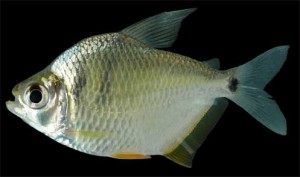
Tetragonopterus argenteus. Source: http://www.ucs.louisiana.edu/~jxa4003/Characiformes%206-15-10%20mh%202.html
24 October 2013 (revised 15 January 2017)
Tetragonopterus Cuvier 1816
Tetragonopterus is a genus of characins from South America. The name of the genus is the origin of the vernacular “tetra” used for many characid fishes in the aquarium trade. Many references (e.g., Wikipedia, Fishbase) tell you that the name translates as “square-finned” (tetra = four; gonio = angle; pterus = fin). However, none of the species in the genus have fins that can be described as “square.” So what does the name mean?
As it turns out, the name is a misspelling and doesn’t mean “square-finned” at all. In 1744, the Prussian naturalist Jacob Theodor Klein proposed the name Tetragonoptrus (note spelling) for quadrate or rhomboidal fishes, particularly marine butterflyfishes (Chaetodontidae). Klein clearly stated that the name meant “quadratus aspectu,” or square appearance.
In 1759, the Dutch natural history collector Albertus Seba (1665-1736) posthumously published a description and illustration of a rhomboidal South American characin from his natural history cabinet, Tetragonoptrus argenteus, assigning it to Klein’s genus. The description was authored by the editor of the work, Arnout Vosmaer.
Predating the official Linnaean start of zoological nomenclature (and not using proper binominal form), both Klein’s and Vosmaer’s names are not available. Instead, the names date to Georges Cuvier (1816), who summarized Vosmaer’s (in Seba) description yet attributed the name to Peter Artedi (1705-1735), whom Seba had hired to catalog and describe his collection.* (In fact, Artedi drowned in an Amsterdam canal after attending a party at Seba’s house.) But for some reason, Cuvier inserted an “e” into the generic name, turning “Tetragonoptrus” into “Tetragonopterus.” Was this a typo on Cuvier’s part? A “correction”? No one knows. But since Cuvier’s was the first publication that validly made the name available, his misspelling is the one we use today — despite not meaning what everyone thinks it means.
We find it charming to know that a name coined by an 18th-century Prussian for marine butterflyfishes in a now-forgotten publication evolved into the word we use for the neons, cardinals and other small characins aquarists keep in their aquariums, and for the name of the aquarium-products giant, Tetra.
(Our thanks to Erwin Schraml and Francisco Welter-Schultes for their bibliographical detective work, which helped us document the history of Klein’s name. And thanks to Isaäc J. H. Isbrücker for elucidating the Seba-Artedi-Vosmaer relationship.)
* Artedi had completed identifications and descriptions of all the fishes in Seba’s collection, except for those on three plates added by editor Vosmaer, after the deaths of Artedi and Seba, including T. argenteus.
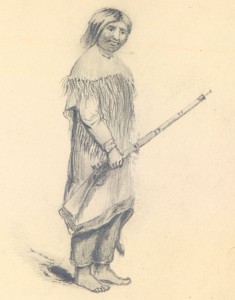
An Umpqua Indian, drawn by Alfred T. Agate. From: http://www.history.navy.mil/ac/exploration/wilkes/wilkes22.html
17 October 2013
Oregonichthys kalawatseti Markle, Pearson & Bills 1999
The specific name of this minnow from the Umpqua River of Oregon, USA, contains a provocative touch of poetry, history and even justice. Say its describers, “Oregon once had a remarkable diversity of native peoples with more native languages than all of Europe. The Kalawatset, a tidewater Umpqua people best known for attacking Jedidiah H. Smith in 1828, were part of this lost human diversity and serve to forewarn of a parallel decline in diversity of Oregon’s native freshwater fishes.”
